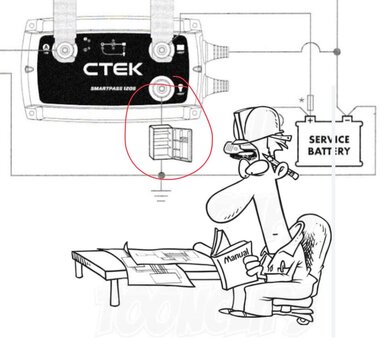Ask Ctek?Still a mystery as to what the actual issue is though.
The Grenadier Forum
Register a free account today to become a member! Once signed in, you'll be able to contribute to the community by adding your own topics, posts, and connect with other members through your own private inbox! INEOS Agents, Dealers or Commercial vendors please use the contact us link at the bottom of the page.
You are using an out of date browser. It may not display this or other websites correctly.
You should upgrade or use an alternative browser.
You should upgrade or use an alternative browser.
You now can’t use the Smartpass consumer output
- Thread starter Noosa John
- Start date
Without the Positive output it's just a SMARTASSView attachment 7830309
Will Ineos or CTEK supply a reissue of a ”CORRECT” version of the manual ????????
- Local time
- 7:41 PM
- Joined
- Aug 24, 2022
- Messages
- 2,458
I think someone has but basically got an ask INEOS answer. I think as far as CTeK are concerned the Smartpass is as they designed it. If there is a problem in the INEOS setup thats a matter for them.Ask Ctek?
- Local time
- 7:41 PM
- Joined
- Aug 24, 2022
- Messages
- 2,458
There are two thoughts I have as to maybe why this may be. Probably neither correct.
1. That using the consumer side while driving causes the alternator to run more often increasing fuel consumption and possibly causing some fuel consumption regulatory issues. (I would ignore that as it’s normal for iff road systems)
1.1 that it puts additional strain on the alternator shortening its life, which would be a worry if a vehicle with a winch and set up for roof lighbars etc was vulnerable to a fridge, so think unlikely.
2. That this causes the second battery to drain while parked and that the system as is cannot charge it enough while driving and so it may not be available as the start backup as INEOS have designed the system. If that’s the case I wonder if the addition of the d250se helps solve that problem.
Maybe it more complex than that, but those are some simple and probably wrong ideas.
1. That using the consumer side while driving causes the alternator to run more often increasing fuel consumption and possibly causing some fuel consumption regulatory issues. (I would ignore that as it’s normal for iff road systems)
1.1 that it puts additional strain on the alternator shortening its life, which would be a worry if a vehicle with a winch and set up for roof lighbars etc was vulnerable to a fridge, so think unlikely.
2. That this causes the second battery to drain while parked and that the system as is cannot charge it enough while driving and so it may not be available as the start backup as INEOS have designed the system. If that’s the case I wonder if the addition of the d250se helps solve that problem.
Maybe it more complex than that, but those are some simple and probably wrong ideas.
Last edited:
Not an electrician however could it be the diversion of load from the alternator while the engine is running?Still a mystery as to what the actual issue is though.
Could Ineos be intending to dedicate the alternator to charging the battery bank as rapidly as possible rather than seeing a percentage loss to consumers connected via this port?
Edit: oh, hang on. I think you had this idea already.
- Local time
- 7:41 PM
- Joined
- Aug 24, 2022
- Messages
- 2,458
Basically yesNot an electrician however could it be the diversion of load from the alternator while the engine is running?
Could Ineos be intending to dedicate the alternator to charging the battery bank as rapidly as possible rather than seeing a percentage loss to consumers connected via this port?
Edit: oh, hang on. I think you had this idea already.
- Local time
- 7:41 PM
- Joined
- Aug 24, 2022
- Messages
- 2,458
Yes I have one in there tooA Noco jump start pack fits nicely into the void next to the 2nd battery, if you are like me and have backups of backups
Ineos has appeared to use the removal of the consumer terminal on the SmartPass as a blanket solution because Ineos cannot control what type of electrical loads and equipment the end user is going to connect into the system. The SmartPass connects the consumer load to the alternator connection while charging the second battery.
Connecting the consumer loads directly to the second battery reduces electrical ripple/spikes and allows the IBS and ECU to manage the charging cycles more efficiently. Is there the possibility the Smartpass switching and fluctuating current and temperature cycles from consumer loads on the alternator are causing the Intelligent Battery Sensor, IBS, and the alternator control system in the ECU to have issues responding to parameters outside of the factory programmed charging algorithm?
Connecting the consumer loads directly to the second battery reduces electrical ripple/spikes and allows the IBS and ECU to manage the charging cycles more efficiently. Is there the possibility the Smartpass switching and fluctuating current and temperature cycles from consumer loads on the alternator are causing the Intelligent Battery Sensor, IBS, and the alternator control system in the ECU to have issues responding to parameters outside of the factory programmed charging algorithm?
Last edited:
Data gathering question-
is anyone aware of a relevant problem any user has had whilst having anything connected to the consumer post of the ctek? And was this with system otherwise unmodified? no d250 or other tech added?
ive see stuff in th3 forum, but dont recall a problem with this port in use. I’d be puzzled if they have a recall action in the absence of such repeat issues, unless it is something found not ny users. In which case Andrews question stands, pls explain why the facility is being removed.
speculating, If its a design issue uncovered in factory/head office we may never be told, as very few companies would publish a hypothetical fault or design mis-step, for lots of reasons.
is anyone aware of a relevant problem any user has had whilst having anything connected to the consumer post of the ctek? And was this with system otherwise unmodified? no d250 or other tech added?
ive see stuff in th3 forum, but dont recall a problem with this port in use. I’d be puzzled if they have a recall action in the absence of such repeat issues, unless it is something found not ny users. In which case Andrews question stands, pls explain why the facility is being removed.
speculating, If its a design issue uncovered in factory/head office we may never be told, as very few companies would publish a hypothetical fault or design mis-step, for lots of reasons.
That's the most coherent explanation I've come across to date. Entirely feasible...Ineos has appeared to use the removal of the consumer terminal on the SmartPass as a blanket solution because Ineos cannot control what type of electrical loads end equipment the end user is going to connect into the system. The SmartPass connects the consumer load to the alternator connection while charging the second battery.
Connecting the consumer loads directly to the second battery reduces electrical ripple/spikes and allows the IBS and ECU to manage the charging cycles more efficiently. Is there the possibility the Smartpass switching and a fluctuating current and temperature cycles from consumer loads on the alternator causing the Intelligent Battery Sensor, IBS, and the alternator control system in the ECU to have issues responding to parameters outside of the factory programmed charging algorithm?
Thank you @NQ94 !
Last edited:
- Local time
- 7:41 PM
- Joined
- Aug 24, 2022
- Messages
- 2,458
I have been running mine with the fridge connected for over a week now with no obvious issues, In factof anything over the past few days I seem to have less warnings etc than usual, almost none in fact. The car says the battery is charged to 98% and I have never seen it over the 80s before.Data gathering question-
is anyone aware of a relevant problem any user has had whilst having anything connected to the consumer post of the ctek? And was this with system otherwise unmodified? no d250 or other tech added?
ive see stuff in th3 forum, but dont recall a problem with this port in use. I’d be puzzled if they have a recall action in the absence of such repeat issues, unless it is something found not ny users. In which case Andrews question stands, pls explain why the facility is being removed.
speculating, If its a design issue uncovered in factory/head office we may never be told, as very few companies would publish a hypothetical fault or design mis-step, for lots of reasons.
Caveats are that I have no idea the states of charge of the second battery as I haven’t tested it, and the longest the fridge has run without the car running has beem about 12 hours so don’t know how it would react if it ran for a couple of days while camping and ran the battery down.
That sounds quite feasible - perhaps the “normal” old (Aussie) setup of having the auxiliary battery running all the accessories is the way to go.Ineos has appeared to use the removal of the consumer terminal on the SmartPass as a blanket solution because Ineos cannot control what type of electrical loads end equipment the end user is going to connect into the system. The SmartPass connects the consumer load to the alternator connection while charging the second battery.
Connecting the consumer loads directly to the second battery reduces electrical ripple/spikes and allows the IBS and ECU to manage the charging cycles more efficiently. Is there the possibility the Smartpass switching and a fluctuating current and temperature cycles from consumer loads on the alternator causing the Intelligent Battery Sensor, IBS, and the alternator control system in the ECU to have issues responding to parameters outside of the factory programmed charging algorithm?
Kindly donated from FB...

… a small number of vehicles?????
says 1 to 4200 but aren't all later being fitted with the new improved ctek?… a small number of vehicles?????
- Local time
- 7:41 PM
- Joined
- Aug 24, 2022
- Messages
- 2,458
Arguably they are being fitted with a lesser Ctek 120 that has the consumer output deleted from factory.says 1 to 4200 but aren't all later being fitted with the new improved ctek?
me threeYes I have one in there too
Similar threads
- Replies
- 10
- Views
- 2K
- Replies
- 27
- Views
- 7K
- Replies
- 1
- Views
- 376




